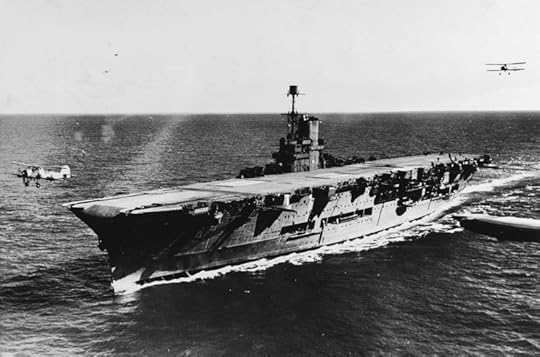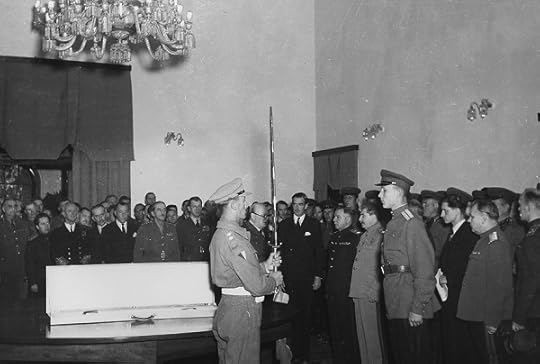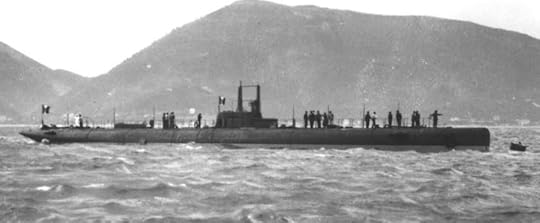Mark Simner's Blog, page 2
November 13, 2018
The Sinking of HMS Ark Royal
 HMS Ark Royal
HMS Ark Royal Launched in 1937, the British aircraft carrier HMS Ark Royal would see much distinguished service during the Second World War. She found herself involved in some of the earliest sinkings of German U-boats, supporting operations in Norway and the hunt for the mighty German battleship Bismarck. As the war progressed, she took part in the vital convoys to the besieged island of Malta. However, on 13/14 November 1941 her luck violently ran out.
In early November, Ark Royal had been...
October 24, 2018
Remembering an Officer of the Great War: Second-Lieutenant Howard Burton
Howard Burton was born in Walsall, Staffordshire in 1896, the son of William and Annie Burton. At the time of the 1901 census he was living with his family at 29 Rutter Street in Walsall, but by the time hostilities broke out in 1914 he was recorded as residing at 29 Emery Street. On the 8 September 1914, he enlisted into the army as a private in the 4th Battalion of the Grenadier Guards. At the time of his enlistment, Burton stated his occupation as a ‘bag maker’ and appears to have been so...
October 21, 2018
Hearts of Steel: The Sword of Stalingrad
 Presentation of the Sword of Stalingrad
Presentation of the Sword of Stalingrad On 29th November 1943 during the Tehran Conference, British Prime Minister Winston Churchill presented Soviet leader Joseph Stalin with a ceremonial longsword. King George VI had asked for the sword to be commissioned in recognition of the defenders of Stalingrad, who had courageously fought for their city between August 1942 and February 1943. Apart from being one of the bloodiest battles of the war, the Allies knew it was an important turning point in...
The Rafwaffe: No.1426 (Enemy Aircraft) Flight, Royal Air Force
No.1426 (Enemy Aircraft) Flight of the Royal Air Force was formed on 21st November 1941 to test and evaluate captured enemy aircraft of the German Luftwaffe. The idea was to gain intelligence on the capabilities and characteristics of these aircraft. As a result, the Flight gained the nickname ‘the Rafwaffe’, although it also evaluated an Italian aircraft of the Regia Aeronautica Italiana.
Upon formation, the Flight was staffed using test pilots from No.41 Group, who set to work evaluating a...
September 6, 2018
Coming Soon | The Lion and the Dragon by Mark Simner
The story of Britain’s devastating drug wars with China, fought between 1839-1842 and 1857-1860
• A new in-depth military history of the Anglo-Chinese Wars
• Written in a lively manner as if the author had witnessed events for himself
• Extensive use of primary and period sources, which present the reader with greater detail on the subject than ever before
• A large number of period images and maps, many of which have not appeared in print for over a century
During the mid-19th century, Brit...
August 30, 2018
The ‘Immortal’ Osman Digna
 Osman Digna c.1899
Osman Digna c.1899 Demonised by some but highly respected by others, Osman Digna (sometimes spelt ‘Uthman Diqna) was a Mahdist leader who remained a thorn in the side of the British in Sudan for almost two decades during the late Victorian period. He was, perhaps, the ablest commander of the Ansar – the Mahdist army – who, despite numerous defeats, refused to give up the jihad against the Anglo-Egyptian authorities. Although largely forgotten in the West today, he is remembered as a hero by m...
August 20, 2018
The Five Shilling Rebellion
 Boer Commandos
Boer Commandos After over two and a half years of bitter fighting, the British finally prevailed over their resilient Boer adversaries in South Africa in 1902. Defeated, the Boers commandos of the Transvaal were asked to sign a pledge that they would adhere to the newly agreed peace terms. Many did, some refused. For those unable to accept defeat only exile followed, but as the years rolled by they were slowly allowed to return to their homes. These men would later be termed ‘bittereinders’ (...
August 3, 2018
Italian Submarine Alberto Gugliemotti: Her Tragic Loss and Rediscovery
 Italian Submarine Alberto Gugliemotti
Italian Submarine Alberto Gugliemotti On 2 August 2018, it was reported by The Telegraph that the wreck of the Italian submarine Alberto Gugliemotti had been found lying on the seabed by two minesweepers of the Marina Militare. The vessel had been lost for over a century since its sinking in 1917.
The Alberto Gugliemotti had been on its way to Brindisi when it was mistaken for a German U-Boat by HMS Cyclamen, a British Arabis-class minesweeper. A brisk action ensued, when the Cyclamen opened...
July 25, 2018
Operation Menace: A Propaganda Victory for Vichy France
 British battleship salvos during Operation Menace
British battleship salvos during Operation Menace The British attack of 3 July 1940 on the French fleet anchored in the Algerian harbour of Mers-el-Kébir would not be the last time the two former allies would clash during the Second World War. Although Winston Churchill believed he had neutralised the potential threat posed by the French warships in the Mediterranean, for now at least, he was concerned about France’s colonial empire. In the wake of the armistice of June and the establishment...
July 24, 2018
Operation Catapult: A Most Disagreeable Task
 Mers-el-Kebir Harbour
Mers-el-Kebir Harbour It was midnight on 25 June 1940 when the armistice, signed three days earlier by French and German representatives at Compiègne, came into force and ended the Battle of France. In a mere six weeks the Germans had conquered much of western Europe, including France, Belgium, Luxembourg and the Netherlands. These unfortunate countries would remain under German occupation for years, until their eventual liberation following the Allied invasion of Normandy in 1944. France, ho...





